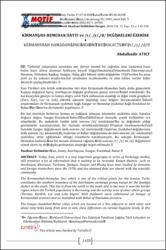| dc.contributor.author | Atıcı, Abdulkadir | |
| dc.date.accessioned | 2021-12-12T16:50:38Z | |
| dc.date.available | 2021-12-12T16:50:38Z | |
| dc.date.issued | 2018 | |
| dc.identifier.issn | 1308-4445 | |
| dc.identifier.uri | https://doi.org/10.12981/motif.469 | |
| dc.identifier.uri | https://app.trdizin.gov.tr/makale/TXpJM05qazJOZz09 | |
| dc.identifier.uri | https://hdl.handle.net/20.500.11857/2362 | |
| dc.description.abstract | Türkoloji çalışmaları açısından son derece önemli bir coğrafya olan Günümüz İranıhalen kayıt altına alınmayı bekleyen birçok bilgiyi muhafaza etmektedir. Azerbaycan,Horasan, Türkmen, Kaşkay, Sungur, Halaç gibi bilinen sözlü değişkeler 1920’lerden bu yanayerli ya da yabancı araştırmacılar tarafından incelenmekte ve elde edilen veriler bilimâlemiyle paylaşılmaktadır.İran Türkleri için kritik noktalardan biri olan Kirmanşah-Hemedan hattı, daha güneydekiKaşkay değişkesi hariç, Azerbaycan değişke grubunun güney sınırını teşkil etmektedir. Buhat kuzeyden güneye ve batıya doğru artık Türk nüfusunun azaldığı ve diğer etnik grupların(Fars, Kürt, Lor ve Lek) etkinlik alanının başladığı sınır bölgesi durumundadır. Alanaraştırmaları ile Kirmanşah eyaletine bağlı Sungur ve Hemedan eyaletine bağlı Esedabad ileBahar illeri üzerine derlemeler yapılmıştır.Bir hat üzerinde birbirine komşu ve yaklaşık altmışar kilometre uzaklıkta olan, batıdandoğuya doğru, Sungur-Esedabad-Bahar illeri dilbilimsel düzeyde çeşitli farklılıklar arzetmektedir. Bu makalede özelde ünlü sonrası /d/ ünsüzünün bu üç değişkede aldığıgörünümler karşılaştırmalı bir biçimde örneklendirilmiştir. Yapılan incelemelerde enbatıdaki Sungur değişkesinin ünlü sonrası /d/ ünsüzünü /r/leştirme, Esedabad değişkesininünlü sonrası /d/ ünsüzünü /y/leştirme ve Bahar değişkesinin de ünlü sonrası /d/ ünsüzünümuhafaza etme eğiliminde olduğu örneklerle tanıklanmıştır. Bu sebeple Kirmanşah-Hemedan hattının, kısa bir mesafe olmasına rağmen, ünlü sonrası /r/, /y/ ve /d/ değişkeleriolmak üzere üç alt değişke grubundan oluştuğu tespit edilmiştir. | en_US |
| dc.description.abstract | Today, Iran, which is a very important geography in terms of Turkology studies, still preserves a lot of information that is waiting to be recorded. Known dialects such as Azerbaijan, Khorasan, Turkmen, Qashqai, Sonqur and Khalaj have been studied by domestic and foreign researchers since the 1970s and the obtained data are shared with the scientific community. The Kermanshah-Hamadan line, which is one of the critical points for the Iranian Turks, constitutes the southern boundary of the Azerbaijani exchange group, except for the Qashqai dialect in the south. This line is from the north to the south and to the west is now the border region where the Turkish population is decreasing and the activity area of other ethnic groups (Persian, Kurdish, Lor and Lek) begins. With fieldwork were collationed on Sonqur of Kermanshah province and on Asadabad with Bahar of Hamadan province. The Sonqur-Asadabad-Bahar cities, which are located on a line adjacent to each other and about sixty miles away from west to east, show differences on various linguistic levels. In this article in particular, the views of the famous post / d / voice in these three variables are exemplified comparatively. In the examinations made, it is witnessed with examples that the westernmost Sonqur exchange tends to maintain the famous post /d/ voice to /r/ sound, the famous post /d/ voice to /y/ sound of the Asadabad exchange and the famous post /d/ voice of the Bahar exchange. For this reason, it was determined that the Kermanshah-Hamadan line was composed of three groups of dialects, namely the famous post /r/, /y/ and /d/. | en_US |
| dc.language.iso | tur | en_US |
| dc.relation.ispartof | Motif Akademi Halkbilimi Dergisi | en_US |
| dc.identifier.doi | 10.12981/motif.469 | |
| dc.rights | info:eu-repo/semantics/openAccess | en_US |
| dc.subject | Folklor | en_US |
| dc.title | KİRMANŞAH-HEMEDAN HATTI ve /r/, /y/,/d/ DEĞİŞKELERİ ÜZERİNE | en_US |
| dc.title.alternative | KERMANSHAH-HAMADAN LINE AND ON THE DIALECTS OF /r/,/y/,/d/ | en_US |
| dc.type | article | |
| dc.department | Fakülteler, Fen-Edebiyat Fakültesi, Çağdaş Türk Lehçeleri ve Edebiyatları Bölümü | |
| dc.identifier.volume | 11 | en_US |
| dc.identifier.startpage | 143 | en_US |
| dc.identifier.issue | 23 | en_US |
| dc.identifier.endpage | 158 | en_US |
| dc.relation.publicationcategory | Makale - Ulusal Hakemli Dergi - Kurum Öğretim Elemanı | en_US |
| dc.institutionauthor | Atıcı, Abdulkadir | |



















